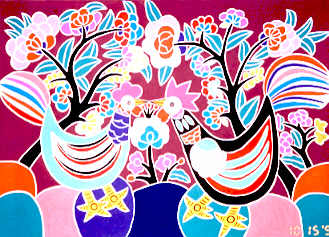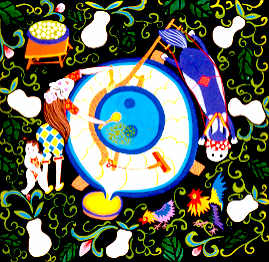
| Events Get There About Teaching Resources Links Contacts Home |
 CHINESE PEASANT PAINTINGS September 11 - October 16, 2005* Opening reception September 11, 1:00 PM -- Informal Gallery Talk 2:00 PM  Chinese paintings that we have known through
art museums, collectors and scholars have a history of 2000
years. A major influence in their development was the written
language which started as pictographs but rapidly developed into
thousands of complex characters, often formed with as many as twenty or
more carefully arranged brush strokes. The complexity of this
written language limited its use to a relatively small number of
scholars and high officials. Calligraphy was, and still is, an
art in itself, and the inks and paper used in its production and the
technique of brush strokes was carried over into painting. The
use of ink and watercolors produced monochromatic or softly tinted
color schemes. Chinese paintings that we have known through
art museums, collectors and scholars have a history of 2000
years. A major influence in their development was the written
language which started as pictographs but rapidly developed into
thousands of complex characters, often formed with as many as twenty or
more carefully arranged brush strokes. The complexity of this
written language limited its use to a relatively small number of
scholars and high officials. Calligraphy was, and still is, an
art in itself, and the inks and paper used in its production and the
technique of brush strokes was carried over into painting. The
use of ink and watercolors produced monochromatic or softly tinted
color schemes.Painters were usually trained first as calligraphers and only later as artists. Early painters were patronized by the court, nobility, the wealthy and religious institutions, and many became government officials. As the dynasties changed, many of the official-scholar-painters were excluded from the government or withdrew of their own will, and as a result they painted for their own enjoyment or to make paintings as presents for their friends. They chose as their subjects animals, birds, flowers and for the bulk of their work the beautiful and often incredibly exotic scenes of Chinese nature. Theirs was often an art of man contemplating nature with a feeling of great solitude.  When the Communists gained control of China in 1948, one of their goals was to eradicate all forms of the ancient culture, including the arts. With their source of strength coming from the vast peasant population, they set out to produce a new Chinese art - peasant art. Actually several forms of peasant art also go back thousands of years, but because they were not considered 'good art' by the ruling classes very few of the actual pieces of art have endured. Paper cutting has been a popular handicraft for centuries. Because paper is cheap, almost any peasant could afford it, and it is widespread as a decoration for peasant homes throughout China. Needlework is also practiced by the peasants as decoration for clothing and other household items. Some of the Communist artists, drawing on these skills, persuaded some of the peasants to begin expressing their ideas through painting, still using inexpensive materials such as tempera paints on paper. This has spread to over fifty different peasant painting groups throughout China. The influence of paper cutting can often be seen in the flat modeling and decorative forms, and of the needlework in the fine lines, almost like stitches. Where a traditional scholar-artist painting in subdued colors might have been an individual quietly contemplating a vast view of mountains and clouds, a typical peasant painting in bright colors is usually crowded with people, and the view is of their work in the fields, orchards and on the rivers. These are scenes of the life of the vast majority of the one billion Chinese people. CHINESE PEASANT PAINTINGS includes fifty contemporary works gathered by Joanna and Hal Retzler and a smaller group of associated paper cuttings and embroideries. All of the paintings are for sale. Mr. Retzler will present an informal talk on the art at 2:00 p.m. during the public reception opening the 2005-2006 season of the Sandusky Cultural Center. Please plan to join us on September 11. |
|
With awareness of cultural diversity
and the
positive values of artistic regionalism, the Sandusky Cultural Center
provides
educational and entertaining exhibits that stimulate an interest in the
fine arts, provide a focus for multicultural awareness, and introduce
complex issues and challenging concepts. |